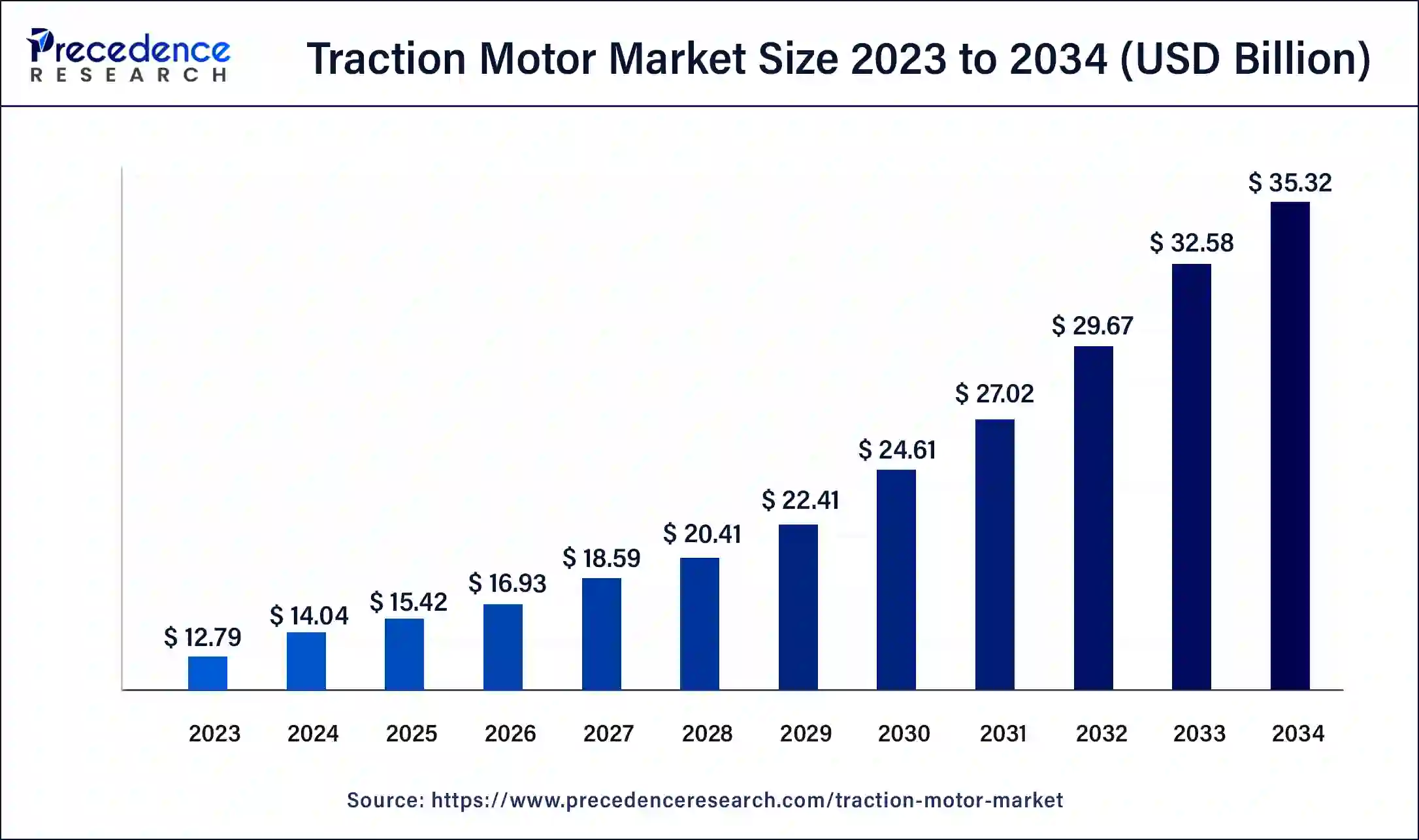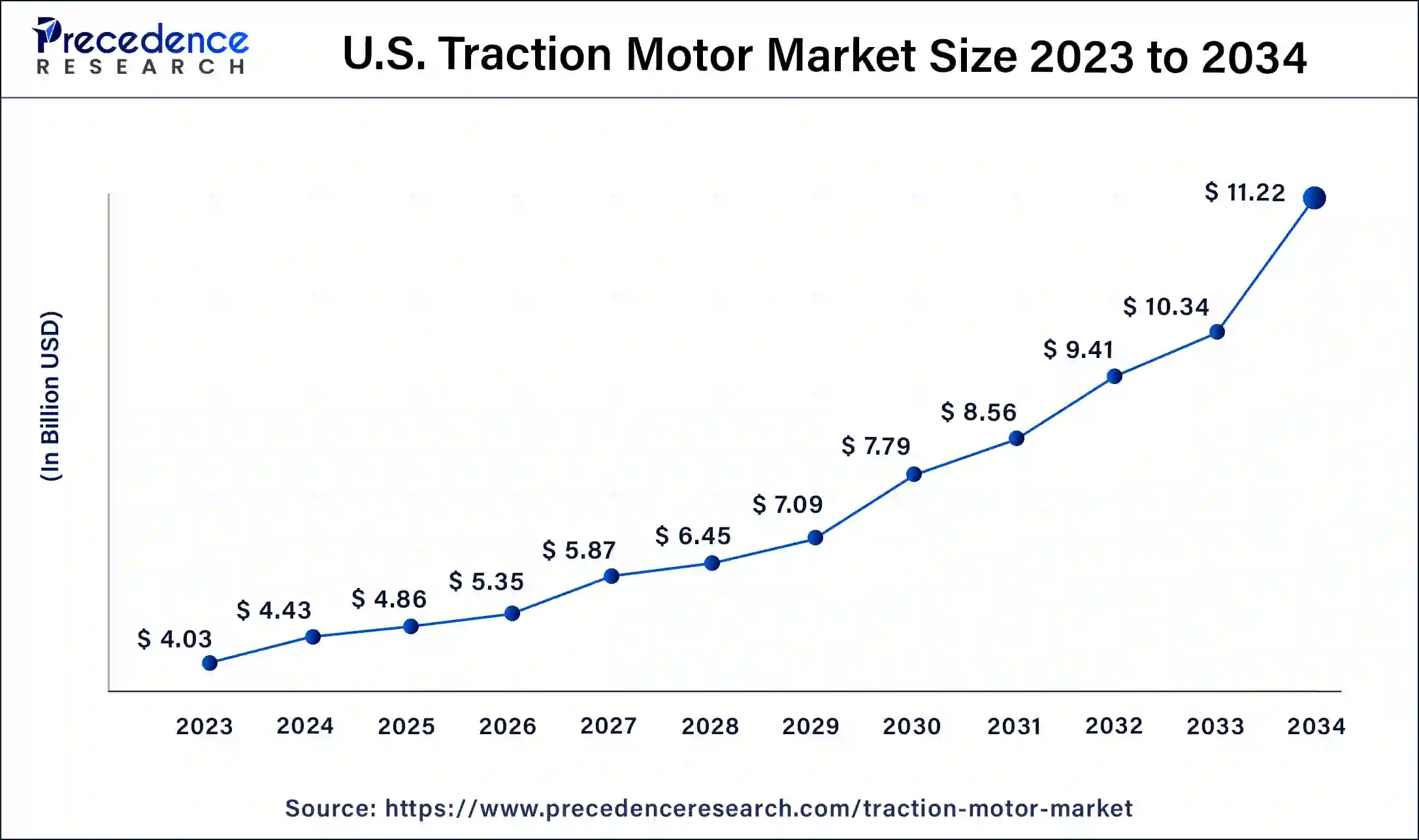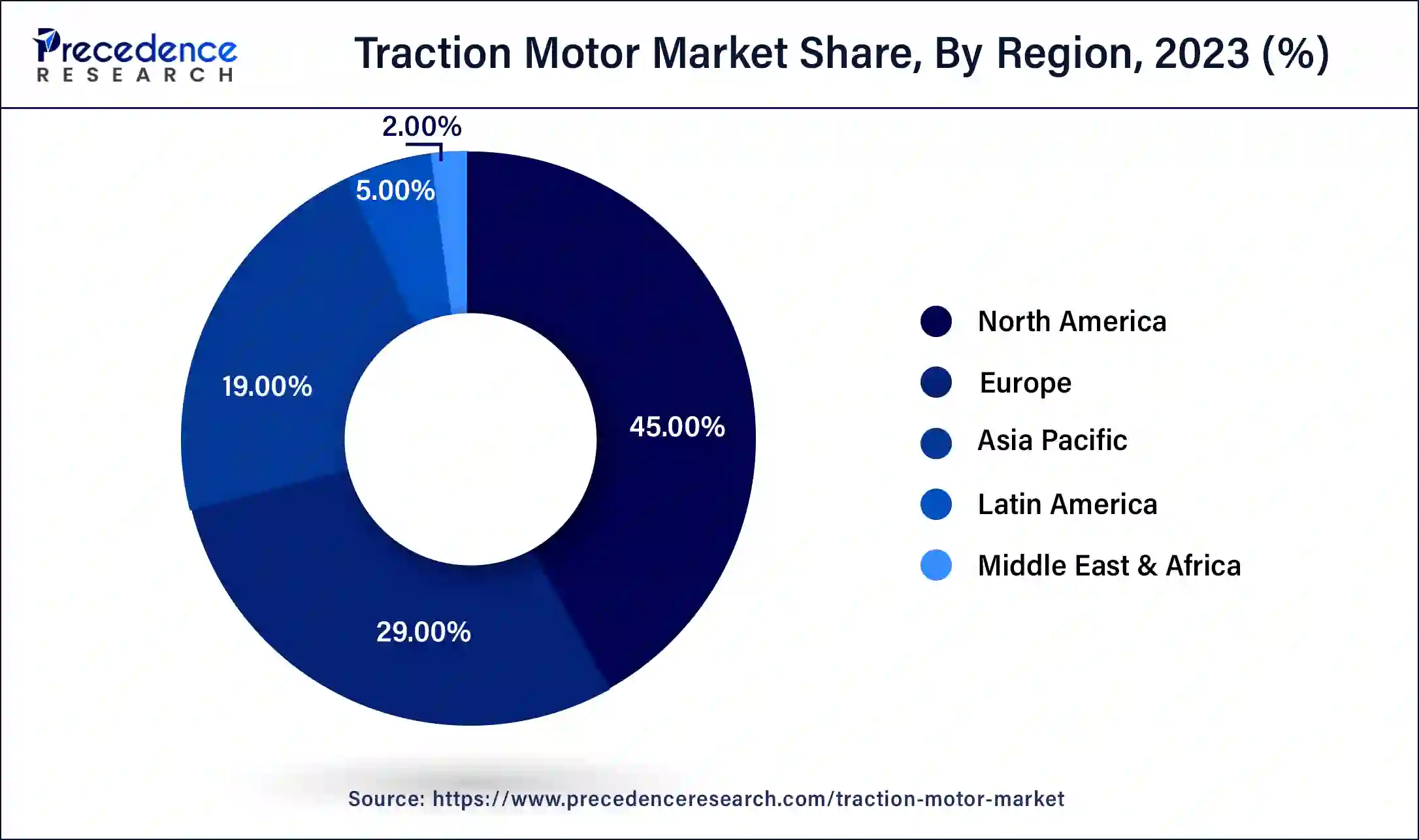January 2025
The global traction motor market size was USD 12.79 billion in 2023, estimated at USD 14.04 billion in 2024 and is anticipated to reach around USD 35.32 billion by 2034, expanding at a CAGR of 9.66% from 2024 to 2034.
The global traction motor market size accounted for USD 14.04 billion in 2024 and is predicted to reach around USD 35.32 billion by 2034, growing at a CAGR of 9.66% from 2024 to 2034.

The U.S. traction motor market size was valued at USD 4.03 billion in 2023 and is expected to be worth around USD 11.22 billion by 2034, growing at a CAGR of 9.75% from 2024 to 2034.

North America has held the largest revenue share of 45% in 2023. North America holds a major share in the traction motor market due to several factors, including the robust presence of established automotive and manufacturing industries, high consumer demand for electric vehicles, and supportive government initiatives promoting clean transportation. The region's emphasis on sustainable practices and technological innovation, coupled with increasing investments in charging infrastructure, contributes to the strong foothold of traction motor technologies. Additionally, the presence of key market players and a growing awareness of environmental concerns further propels North America's prominence in the traction motor market.

Asia-Pacific is estimated to observe the fastest expansion. Asia-Pacific holds significant growth in the traction motor market due to the region's robust industrial growth, urbanization, and increasing demand for electric vehicles. The automotive industry's rapid shift towards electrification, along with supportive government policies and initiatives promoting clean energy, has propelled the traction motor market in Asia-Pacific. Additionally, the rising investments in transportation infrastructure, including railways and metros, contribute to the region's dominance, making it a key player in the global traction motor market.
A traction motor is an electric motor specially crafted for electric or hybrid vehicles, serving the crucial role of translating electrical energy from the vehicle's power source typically a battery or a combination of a battery and an internal combustion engine into the mechanical force required to propel the wheels. These motors are commonly integrated into electric cars, trains, and buses. They are recognized for their capacity to deliver substantial torque at lower speeds, making them pivotal for efficient vehicle acceleration. In the realm of electric vehicles, traction motors significantly influence energy efficiency, affecting factors like range and overall performance.
Continuous improvements in traction motor technology, with a focus on boosting power density, efficiency, and regenerative braking capabilities, contribute to the ongoing evolution of sustainable and eco-friendly transportation solutions. As the automotive industry transitions towards increased electrification, the role of traction motors in facilitating efficient and environmentally conscious mobility becomes increasingly prominent.
| Report Coverage | Details |
| Growth Rate from 2024 to 2034 | CAGR of 9.66% |
| Market Size in 2023 | USD 12.79 Billion |
| Market Size in 2024 | USD 14.04 Billion |
| Market Size by 2034 | USD 35.32 Billion |
| Largest Market | North America |
| Base Year | 2023 |
| Forecast Period | 2024 to 2034 |
| Segments Covered | Type, Vehicle Type, End User, and Region |
| Regions Covered | North America, Europe, Asia-Pacific, Latin America, and Middle East & Africa |
Electric vehicle adoption and rising fuel costs
The surge in electric vehicle (EV) adoption and escalating fuel costs are pivotal drivers propelling the traction motor market. With the global shift towards sustainable transportation, the demand for EVs has experienced a substantial upswing. Traction motors play a central role in powering these electric and hybrid vehicles, converting electrical energy into the mechanical force required for movement.
As consumers increasingly prioritize eco-friendly alternatives and governments implement stringent emission regulations, the traction motor market benefits from the heightened interest in EVs as a cleaner and more sustainable mode of transportation. Rising fuel costs further amplify the traction motor market's growth trajectory.
Escalating prices at the pump incentivize consumers to explore electric alternatives, where traction motors are instrumental. Electric vehicles not only offer a greener solution but also present long-term cost savings, making them an economically attractive option. As the cost-effectiveness and environmental benefits of electric mobility become more apparent, the traction motor market is poised to experience continued expansion, driven by the dual forces of heightened EV adoption and the economic considerations associated with rising fuel prices.
Limited charging infrastructure
The limited availability and accessibility of charging infrastructure emerges as a significant constraint restraining the growth of the traction motor market. The expansion of electric vehicle (EV) adoption heavily relies on the development of a robust charging network. The scarcity of charging stations, particularly in certain regions, induces "range anxiety" among consumers, dissuading them from embracing electric vehicles equipped with traction motors.
The insufficient infrastructure not only hampers the convenience of EV use but also curtails the potential market for traction motors, as consumers are hesitant to switch to electric alternatives without the assurance of a reliable and widespread charging network. To unlock the full potential of the traction motor market, concerted efforts are needed to accelerate the deployment of charging infrastructure, addressing the critical barrier that limited charging options pose to the broader acceptance and adoption of electric vehicles and their associated traction motors.
Global electrification initiatives
Global electrification initiatives are creating significant opportunities for the traction motor market by driving a paradigm shift towards sustainable transportation. Governments worldwide are intensifying efforts to reduce carbon emissions, with a strong focus on promoting electric vehicles (EVs) as a key component of their electrification strategies. This presents a substantial growth avenue for the traction motor market, as EVs heavily rely on these motors for efficient electric propulsion.
As nations commit to phasing out traditional combustion engine vehicles, the demand for traction motors is set to surge. Substantial investments in charging infrastructure, coupled with supportive policies and incentives, contribute to a conducive environment for the traction motor market to thrive. The global push towards electrification not only aligns with environmental goals but also positions traction motors as pivotal components in the transformative journey towards cleaner and more sustainable mobility on a global scale.
In 2023, the A.C. induction motor segment had the highest market share of 69% on the basis of the type. The A.C. induction motor segment in the traction motor market refers to motors that operate on alternating current, commonly used in electric and hybrid vehicles for their simplicity and reliability. A significant trend in this segment is the continued enhancement of motor efficiency and control systems.
Manufacturers are focusing on developing advanced technologies to optimize the performance of A.C. induction motors, resulting in improved energy conversion, reduced energy loss, and enhanced overall efficiency, aligning with the broader industry goal of achieving more sustainable and efficient electric propulsion systems.
The permanent magnet motor segment is anticipated to expand at a significant CAGR of 10.4% during the projected period. The permanent magnet motor segment in the traction motor market refers to motors utilizing permanent magnets to generate a magnetic field, enhancing efficiency and power density.
A trend within this segment involves increasing adoption due to the superior performance and compact design, contributing to the overall efficiency of electric vehicles. The demand for permanent magnet traction motors is escalating as manufacturers prioritize these advanced motors for their role in achieving higher energy efficiency and improved driving range, aligning with the growing prominence of electric and hybrid vehicles in the automotive landscape.
According to the vehicle type, the passenger cars segment has held a 59% revenue share in 2023. The passenger car segment in the traction motor market refers to electric motors powering vehicles designed for personal transportation. In recent trends, there is a notable surge in the adoption of traction motors in passenger cars, driven by the increasing popularity of electric vehicles (EVs). With advancements in motor technology, passenger EVs are experiencing improved efficiency, extended driving ranges, and enhanced performance. This trend reflects a growing consumer preference for eco-friendly mobility options, contributing to the traction motor market's expansion within the passenger car segment.
The commercial vehicles segment is anticipated to expand fastest over the projected period. The commercial vehicles segment in the traction motor market encompasses electric propulsion systems for buses, trucks, and vans. A growing trend within this segment is the increasing electrification of commercial fleets. As businesses and municipalities prioritize eco-friendly alternatives, the demand for traction motors in electric commercial vehicles is on the rise. This trend is fueled by factors such as reduced operational costs, environmental sustainability goals, and governmental incentives, positioning the commercial vehicle segment as a key driver for traction motor market growth.
According to the end user, the hybrid vehicles segment held a 41% revenue share in 2023. Hybrid vehicles, as an end-user segment in the traction motor market, refer to vehicles that combine an internal combustion engine with an electric propulsion system. In this segment, traction motors play a crucial role in providing electric power for propulsion and supporting functions like regenerative braking. A key trend in the hybrid vehicle segment is the increasing integration of advanced traction motor technologies, enhancing efficiency and contributing to the overall performance of these vehicles as the automotive industry continues to emphasize greener and more sustainable transportation solutions.
The escalators segment is anticipated to expand fastest over the projected period. In the traction motor market, the escalators segment pertains to the use of traction motors in escalator systems. Traction motors play a crucial role in providing the necessary power for smooth and efficient vertical transportation. Trends in this segment include the adoption of energy-efficient and low-maintenance traction motors, aligning with the growing emphasis on sustainability in urban infrastructure. The integration of smart technologies for enhanced escalator performance and reliability is another notable trend, as the market seeks innovations to meet the evolving needs of end-users in public spaces and commercial buildings.
Segments Covered in the Report
By Type
By Vehicle Type
By End User
By Geography
For inquiries regarding discounts, bulk purchases, or customization requests, please contact us at sales@precedenceresearch.com
No cookie-cutter, only authentic analysis – take the 1st step to become a Precedence Research client
January 2025
September 2024
December 2024
January 2025